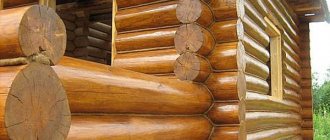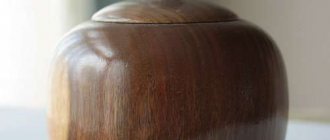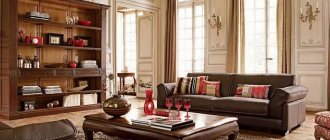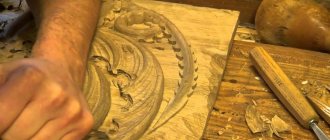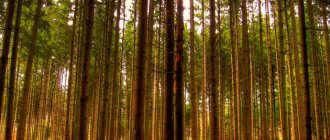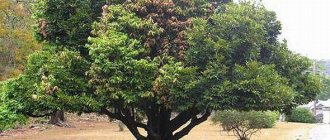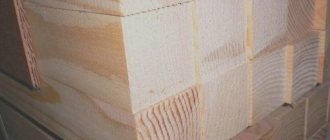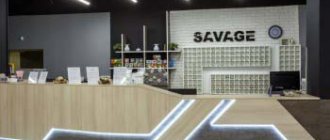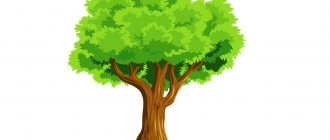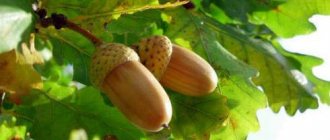Cherry
The breed is sound. The cherry sapwood is narrow and yellowish. Mature wood is pink-brownish, sometimes pink-grayish. The structure of the wood is even-grained with a relatively uniform texture. A radial section clearly reveals the striping characteristic of wood. Cherry wood is very decorative, has a beautiful warm shade, but darkens over time. In terms of hardness, it is significantly softer than oak and lends itself well to all types of processing.
Density: 580 kg/m3.
Hardness: 3.0 - 3.3.
Rowan
The species is sound and has wide sapwood of a reddish-brown color. The wood is dense, hard, strong, heavy, fire-resistant, and has good impact resistance. Poorly processed. Drying freshly cut wood is not so easy. If drying is careless and too hasty, the wood becomes covered with many large and small cracks. It is much safer to use wood from dried rowan trees.
Rowan wood stains well and accepts mordant. After sanding and polishing it acquires a beautiful silky shine. Dense and uniform, it can be easily processed with cutting tools and is an excellent material for turning and carving. Moreover, the carving can be made very thin.
Wood types: Apple
Apple tree (Malus) is a genus of deciduous trees and shrubs of the Rosaceae family - a tree with hard wood that dries out strongly, although it is not easy to dry it. Products made from well-dried wood never crack or warp. Under favorable conditions, a wild apple tree can live up to 200 years, forming a trunk with a diameter of up to 40 cm.
Wild species of apple trees (in the Caucasus Mountains, in the Kursk and Voronezh regions, are classified as group I forests and are considered especially valuable forests; the largest tracts of apple forests are in the mountains of Kazakhstan) are trees up to 20 m high, with a trunk diameter of up to 40 cm. They grow They are found alone, in small groups or groves in the second tier of tree stands, on forest edges and clearings, in light woodlands of mountain slopes or mountain gorges at an altitude of 800-1000 to 1500-1600 m, as well as in river valleys. Sometimes the apple tree forms plantations - the so-called apple forests - in which it is the predominant species. Many wild species of apple trees are frost-resistant, so they can be found in places ranging from the forest-steppe zone to the border with the taiga zone.
The apple tree is a scattered-vascular heartwood species. Around the red-brown core there is yellow-pink wide sapwood. Sometimes the difference in color between the heartwood and the sapwood is slight. The transition from early wood of the annual layer to late wood occurs gradually. The annual layers of the apple tree are slightly sinuous and unequal in width. Each annual layer either narrows or expands, forming an irregularly shaped ring. They are visible in all sections, but a particularly clear texture pattern appears on the end section. The apple tree has very narrow medullary rays that are indistinguishable to the naked eye.
Apple tree belongs to species with high uniform density, i.e. to those that do not have a sharp difference between the structure of the late and early wood of the annual layers, along with maple, pear, beech, alder, aspen, linden and a number of other species. Like most scattered-vascular hardwoods, the anatomical unevenness of the surface of longitudinal sections of wood is 30 - 100 microns, which ensures high quality finishing (sanded and polished) of products made from this wood.
Apple tree wood is hard, heavy and highly drying. The average density for wild apple tree species is about 700 kg/m3 at a standard humidity of 12%. In terms of its strength characteristics, the apple tree is somewhat inferior to other fruit species (cherries and especially pears). The sufficiently high wear resistance of apple wood allows it to be used (along with cherry and pear) for the manufacture of parquet. The ability to hold fasteners (resistance to pulling out nails and screws) is at the level of pine and pear.
Due to the high swelling coefficient, bending apple wood is much more difficult than other fruit species. In terms of resistance to biological damage, the apple tree is classified as a medium-resistant species. It is satisfactorily impregnated with protective compounds.
Forest apple wood is much better than home apple wood for two reasons. Firstly, it is noticeably stronger and less susceptible to biological damage, and secondly, its trunk is almost straight, and this makes it possible to make large workpieces.
During the drying process, apple wood tends to crack and warp, so careful selection of the drying regime is required. Just as in the case of maple, preliminary natural drying of freshly sawn materials in stacks protected from sunlight and precipitation is recommended to a humidity of 20 - 25%. The shape and size stability of apple wood products is average to good.
Apple wood is difficult to split, but can be processed well with all types of cutting tools, is excellent for turning and carving work, and also glues, tinted, painted and varnished well.
Cutting tools leave a smooth, glossy cut on the wood, which is important when making very fine carvings and is especially valuable when working on miniature sculpture.
Apple wood is valued for its high strength and low abrasion. It is known that the teeth of wooden rakes quickly wear out and break, clinging to meadow turf and hummocks. But the life of the teeth can be extended if they are cut from apple wood. Those who often have to do carpentry also prefer to cut a plane block from apple wood. This last, with a glossy, smooth sole, is heavy, durable, and can serve the master for decades.
Apple wood can be sanded, polished and polished perfectly. Impregnated with linseed oil or natural drying oil, it acquires higher strength and a deep dark brown color. Small products made from apple wood, boiled in oil or drying oil, are especially strong and hard as bone.
The wood of apple trees growing in a helical shape, as well as the wood of the butt part of the trunk and root, has an original texture. After sanding and polishing, a beautiful wavy pattern appears on the products.
Branches and roots are used for firewood, which can be used when smoking hams. Apple wood has no resin, and therefore does not smoke or form thick soot. In light light smoke, the ham becomes golden, and to make it fragrant, at the end of smoking, a juniper branch is thrown into the fire.
Birch
The wood is white with a yellowish or reddish tint. The annual layers are poorly visible. The medullary rays are visible only on strictly radial sections (splits). Karelian birch wood is tough and hard, easy to carve. Among light deciduous species it has no equal in the beauty of its texture. It is highly valued in mosaic works and as an ornamental material.
Unlike other types of wood, birch does not have significant differences in the properties of radial and tangential cuts, but is very susceptible to the influence of moisture, for which experts classify it as a so-called “capricious” species. Birch wood is perfectly tinted, opening up almost unlimited design possibilities.
When drying, the wood may become warped. After drying, the wood is smooth, with a matte shine, and its surfaces are easy to finish.
Density: 630 kg/m3
Hardness - 2.1–3.6
Wood species are known to vary in hardness. Oak, boxwood, palm, yew, walnut, pear are considered hard, and linden, poplar, alder, aspen, willow, spruce, cedar, and pine are considered soft. The middle position is occupied by birch.
The best materials for carving are considered to be linden, aspen, alder and other hardwoods; among conifers, cedar, yew, pine, fir and larch are most often used.
“If it weren’t for bast and birch bark, the man would fall apart,” says the saying. Since time immemorial, linden has been valued by woodcarvers, not only for its lightness, pliability, fine-fiber structure and white color of wood, but also because it can be used to make the most complex and delicate carvings.
Aspen, whose wood is white, soft, uniform, with a faint greenish tint, is often used in turning and carving work, and for making spoons.
Alder has been considered a “chameleon tree” since ancient times. The wood of freshly cut alder is white; in the air it quickly turns red, then turns slightly pale and turns pink. It is light, has a uniform structure, is subject to little warping, is easy to cut and is widely used in decorative and applied arts.
Birch, due to the white color of the wood with a yellowish tint, its uniformity, viscosity and hardness, is used in turning and carving work.
Maple wood is white, with a yellowish tint and a beautiful texture, hard, tough, durable. Polished along a radial cut, in the old days it was called a “peacock’s” eye. Maple was used to make tables, shoe lasts, and printed forms for gingerbread, and maple spoons at fairs were valued four times more than birch, aspen and linden spoons.
Oak wood is distinguished by its uniformity, density, viscosity and extraordinary strength. It was used to make caskets, dishes, church utensils, chests and other household items.
Burls and suvels are widely used in carving. A burl, or kapo-root, is a growth on the trunk or basal part of a tree. Its texture is beautiful, with fancy dotted eyes, and unusually dense. Suvel is a rounded growth on a tree trunk. The cross section has a beautifully curved texture.
Material for crafts can be taken from places where planned logging was carried out, clearings were cut, from uprooted trees, dead wood, and non-viable young growth (with the permission of the forester). Under no circumstances should you use growing, living trees for this.
Author: L.A. Chesnokov
Linden
Nuclear-free breed. The wood is white with a slight pinkish tint; annual layers are faintly visible only in transverse and tangential sections; narrow medullary rays are visible in transverse and radial sections. Linden wood has a uniform structure, is soft, easy to cut, cracks little and warps slightly. Its wood is resistant to dampness, but is susceptible to wormholes. Linden has almost no tannins, so it is difficult to pickle and paint. For coloring, wood is saturated with tannins.
Nut
The species is sound, the wood is most often brown and gray in a wide variety of shades, vaguely delimited from the wide grayish sapwood. The pattern of wood fibers is very rich, wavy, with wide, powerful streaks. The wood is hard and moderately heavy, easy to machine, easy to cut, very flexible, and does not crumble when carving small elements; sharpened and finished. When finished, it acquires a deep brown tint with a pleasant, noble pattern. Walnut has wood that has a variety of color shades - from greenish-gray to reddish-brown. The texture is characterized by large winding stripes of different shades, dark dots and dashes, evenly distributed across the annual layers. The older the walnut, the more valuable its wood. The burls of this tree in the form of sliced veneer are an excellent material for mosaic work. Walnut is highly valued by woodcarvers, as its wood is dense but malleable. Thanks to the presence of tannins, its wood is easily tinted and painted in various colors. A variety of walnut - Anatolian walnut - has an expressive texture in the form of dark straight or slightly curved stripes on a golden-gray background. The wood is dense, durable, easy to cut and finish.
Density: 600–630 kg/m3
Hardness: 5
Hardwood
Various methods are used to determine the hardness of materials (including wood). To determine hardness, tests are most often carried out using the Brinell and Rockwell methods.
According to the Brinnell method, a steel ball is pressed into the material under load, then the depth of indentation is measured. After this, the formulas are used to calculate the hardness in units designated HB.
When studying Rockwell hardness, a steel ball or (for the hardest materials) a diamond cone is also pressed into the material. Hardness, depending on the measurement scale used, is designated as HRA, HRB and HRC.
Based on the measurement results, a list of wood types by hardness was compiled. Below is a list of wood species, from hardest to softest (according to Brinell).
Jatoba
This tropical tree has very durable wood, its hardness is 7HB. Jatoba is native to the humid tropics of South and Central America. The wood is quite light, grayish in the sapwood. The heartwood is red, red-brown or dark orange in color and has yellow, orange and red banding. Cut wood darkens within 6-7 days and becomes brick red. Jatoba is called "Brazilian" or "South American cherry".
The height of a mature tree reaches 40 meters. The wood is used to make furniture, flooring and parquet boards. Jatoba is used to make elements of decorative interior decoration.
Sucupira
The hardness of the wood is 5.6HB. Sucupira grows only in the Amazon rainforest. The height of a mature tree reaches 30 meters. The core of the trunk consists of red-brown "dull" wood. The outer part, the sapwood, is lighter, whitish. In the cut, yellow stripes of parenchymal matter are clearly visible. The texture of sucupira is unique and differs from the structures of other types of wood. It is beautiful, and the oily substances contained in the wood make it resistant to destruction by woodworms and fungi. Sucupira is used to make floor boards, parquet boards and furniture. The wood is difficult to saw, but takes sanding and polishing well.
Turmoil
The hardness of mutenia wood is 5HB.
This tree grows in the humid tropics of West Africa. It grows 60 m in height. Muthenia wood is brown, like walnut, olive with a brownish tint. The violet “rays” give the material a special beauty. The structure of muthenia wood is similar to teak wood.
Mutenia is used for the manufacture of flooring boards, furniture and elements of interior decoration of buildings.
Merbau
The hardness of merbau wood is 4.9HB. Merbau is native to the humid tropics of Papua and New Guinea and the forests of southeast Asia. An adult merbau tree grows up to 30 meters. The wood is dense (the weight of a cubic meter reaches 800 kg), the core is painted light orange or yellow. Merbau sapwood is light yellow. The wood darkens over time, becoming bronze or brown, with a silvery tint. The fibers are straight or crooked and create a beautiful texture. Merbau is resistant to moisture and is suitable for decorating bathrooms. Merbau wood is used to make parquet boards, furniture, and strong, durable buildings.
Canadian maple
There are 200 maples native to Eurasia and North America. Canadian maple wood has a hardness of 4.8HB.
Maple grows up to 20 meters in height. Its wood is white, uniform in structure, with clearly visible growth rings. The section clearly shows heart-shaped rays of light gray color. Maple does not swell with water and bends well when treated with steam.
Most of the maple wood is used to make furniture, parquet boards, gun stocks, plywood, musical instruments, jewelry boxes, handicraft carvings, and antique wooden dishes. Maple cuts well and polishes easily.
Yarra Australian eucalyptus
The hardness of Australian jarrah according to Brinnell is 4.7-5 HB. The tree grows up to 35-40 m, and up to a height of about 20 m it has no knots at all, which has a positive effect on the quality of the wood. The color of the wood of young trees is varied - from pinkish to rich purple shades. Mature trees have dark red wood. The sawn wood darkens in the air, becoming crimson-red. Products made from this wood are very beautiful, but the finished material is prone to cracking and changing shape when dried. Therefore, lumber is processed after drying. Yarra cuts and polishes well. Wood is used to make veneer, parquet, furniture, musical instruments, and sports equipment. In Australia, bridges, buildings, piers, and telegraph poles are built from it.
Yarra Amazonian
The hardness of Amazonian yarra is about 6HB, its homeland is South America. Amazonian yarra has a dark reddish or plum colored heartwood. The sapwood of the tree is lighter yellowish or brownish. Amazonian jarra wood darkens from exposure to air and moisture, its texture consists of small fibers, and there is no sharp boundary between the sapwood and the heartwood. Amazonian yarra is difficult to process, but it polishes and bends well. This wood is used as a material for the construction of buildings and boats, furniture and a wide variety of things are made from it.
Pink tree
The hardness of rosewood is 4.4HB, it grows only in the forests of Guatemala and Brazil and produces one of the most expensive types of wood. The height of an adult tree is 25-28 meters. The wood has the scent of fresh roses and is brightly colored (pink and dark red, banded heartwood and yellow sapwood). Aromatic oil is obtained from rosewood shavings, which is used in the perfume industry and cosmetology.
Rosewood is perfectly dried, sawn, cut and polished perfectly. It is used to make decorative boxes and cigar boxes (humidors), musical instruments, souvenirs and wooden elements of gift weapons, and decorative interior elements.
Ash
The hardness of ash wood is 4HB. This is a very common tree species, it grows throughout Europe and Asia (European ash) and on the American continent (American ash). A mature tree grows to 35 meters or more in height. The wood of young trees is uniform, light, slightly grayish. In mature trees, the color of the core is brown, brown, gray. Some types of ash have heartwood and sapwood of reddish and yellowish shades.
The grain of the wood is straight, and the structure of the wood is large and complex and resembles the structure of oak. The growth rings are clearly visible and create a striped pattern. Wood rays are also developed, especially in the lower part of the trunk.
The scope of application of this type of wood is large; boards of various sizes, plywood, furniture, including bent furniture, and veneer are made from it. In the Middle Ages and in ancient times, weapons, hunting equipment, siege weapons and catapults were made from ash.
Oak
The hardness of oak is 3.8HB. There are 600 known species of this tree. Oak wood is resistant to atmospheric air and does not rot when exposed to water.
The color of the wood is white, yellowish, brownish in various shades, with well-defined annual rings. The sapwood of some oak species is much whiter than the heartwood.
Oak, which has lain for several centuries at the bottom of a reservoir, does not rot or decompose, but becomes a durable, very hard material of a dark brown or almost black color.
The wood structure has high decorative properties, is easy to cut and polish. Oak is a valuable type of wood; a wide variety of things are made from it: furniture, parquet boards, wooden parts of carriages and other vehicles, barrels.
Bog oak is a valuable material for artistic carving, making carved panels, stairs, railings, furniture, doors and trim, interior elements, and wooden sculpture. This material is still used in shipbuilding (stairs, railings, flooring, finishing).
Beech
The hardness of beech is 3.8 HB, this species is widespread in the central and western parts of Europe, the height of a mature tree reaches 35 meters. Beech fiber is smooth and straight, without strands or defects. Beech wood has a yellowish or pinkish color; its structure is a homogeneous, dense material. Mature trees over 80-85 years old have a red heartwood. This unevenness disappears after steaming the wood, this procedure gives the beech a uniform brown, slightly reddish color.
Steamed beech bends well; furniture in the style of Viennese chairs, bent parts for armchairs and other furniture are made from it.
Beech has proven itself well as a building material; it is a raw material for the production of cellulose. It is also used to make boards, veneer, plywood, furniture, shavings, and viscose. In total, there are about 200 types of uses for this tree.
Rowan
The hardness of rowan is 3HB. This tree is widespread; there are 48 species of rowan.
Rowan wood is used to a limited extent; it shrinks significantly when dried and is highly fire resistant.
Rowan sapwood, depending on the type, is white with a red tint or light yellowish. The rowan kernel is dark, brown or reddish brown.
This tree is not cut down on an industrial scale. It is harvested to a limited extent for the manufacture of furniture, souvenirs, and wooden tool handles.
Apple tree
Apple wood is soft or medium hard. The apple tree has a brownish-red heartwood and white, reddish sapwood. The annual rings are usually well defined, the wood fibers are straight and wavy. The disadvantage of apple tree wood is that woodworms can settle in it and render furniture and other products unusable. The dense structure of the apple tree allows you to make very fine and elegant carvings.
Pear
Pear wood is dense and viscous, hard and heavy in weight. When dried, the material loses a lot of weight due to shrinkage. The color of the wood is even, brown, with a pink tint. The pattern of the annual layers is almost invisible on the cut. After drying, pear wood is suitable for making furniture, small items, boxes and souvenirs. When dried, the material does not lose its shape, which makes it possible to make musical instruments from it. Several decades ago, pears were used to make drawing boards, drawing supplies, and instrument parts.
Nut
European walnut (walnut) grows in southern Europe and Asia Minor. The hardness of wood is 5HB. Walnut produces expensive wood, highly valued by lovers of natural materials. Walnut wood has an even, parallel fiber structure; in some areas the fibers create wavy curvatures. Trees living in the northern parts of the range have lighter wood, while southern varieties of wood are darker and more expensive.
The core wood is dark brown or gray. The sapwood is light gray, brownish, of various shades. Walnut wood is a high-quality raw material for the production of furniture, parquet and veneer, sculptures, and souvenirs. Finished walnut products can be spoiled by the wood boring beetle.
American walnut has the same properties as walnut, but the hardness of its wood is less and equal to 4HB.
Cherry (cherry)
The hardness of cherry wood is 3.5 HB. Both European and American cherry are used in woodworking. The tree grows to a height of 25 meters. Cherry wood is used to produce veneer and furniture in limited quantities, tool handles, souvenirs, and toys. Cherry products should be used indoors, as precipitation contributes to the rotting and destruction of wood. Wood-boring beetles can also damage wood.
The cherry kernel material is dark, brown, sometimes with red tints. The sapwood is light yellowish. The annual rings are clearly visible in the cut. The structure of the wood is finely and finely banded. American cherry has darker sapwood than European cherry.
Birch
The hardness of European birch wood is 3HB, Karelian (Scandinavian) birch wood is 3.5HB. Birch wood is durable, uniform, white or yellowish in color. European birch has whiter wood than Karelian birch.
American birch is distinguished by the distribution of strands, in contrast to the wood of European species.
Birch is elastic and lends itself well to any tools for turning and carving. The structure of the wood is very delicate and beautiful; the pattern of Karelian birch after staining is especially contrasting and original.
Birch wood is widely used in a wide variety of industries. It is good for making light-colored furniture and musical instruments, handles, souvenirs and toys. Birch is used to make spindles, reels and bobbins for winding threads in textile production.
Elm
The hardness of elm wood is 3HB. There are 35 species of this tree. The elm grows up to 40 meters in height. The sapwood of the elm is light brown, the heartwood of the tree is much darker. It is well developed in mature trees. The annual rings are visible on the cut and the core is well separated from the sapwood.
Elm takes polishing and processing well with any tool. This is a strong, well-bending wood; it is used to make high-quality arches and rims, furniture, plywood, and vehicle interior items. Elm is a favorite tree of urban landscapers.
Chestnut (horse)
Chestnut wood is light, almost white, with a slightly wavy structure. It is soft, homogeneous and viscous. Chestnut is resistant to fungi and wood-boring beetles. This material makes beautiful parquet boards and furniture. Chestnut wood takes polishing and any treatment well.
Hard conifers - larch and juniper
Larch
The hardness of larch wood is 2.6HB. The tree trunk has a dark reddish core. Larch sapwood is lighter, yellowish-red. The sapwood is separated from the core by a clear boundary; the annual rings on a cut tree are clearly visible.
Larch perfectly resists rotting processes. Houses built from this wood last hundreds of years; the lumber shrinks slightly.
Larch wood is viscous, and its processing is a labor-intensive and slow process. Exposure to water significantly increases the hardness of deciduous wood and its resistance to destruction processes (soaked wood is “hard as stone”). Dams, pillars and bridges made from this material last for decades. Houses are built from larch, boards, furniture, and outdoor sculptures are made.
Juniper is a hard coniferous tree, including 70 species. Juniper is characterized by a peculiar coniferous smell of wood, which remains in the finished product for years. The core of the tree has a dark brown, brown color. The sapwood of the wood is light, greenish-yellow or light yellow. This is a dense, strong rock that accepts any processing and polishing well, and does not chip when cutting (by hand or on a lathe) and sawing. Juniper wood is used to a limited extent for making small objects, toys and souvenirs.
Properties and structure Species and varieties Drying and preparation Processing Tools
Visitors who viewed this article were also interested in the following:
Basic properties and characteristics of oak wood General information Oak wood has always been associated with the concept of strength, power, and health. 337
Softwoods: varieties and their applications Softwoods mostly include wood from evergreen coniferous trees. 215
Walnut wood Properties and characteristics Walnut as a species was formed in Central Asia. Now…
Lawson's cypress Snow White Lawson's cypress Snow White is a low shrub, 1-1.2 meters high and 60-70 cm in diameter.…
Cypress Top Point Cypress "Top Point" is a fairly popular plant in landscape design, but this miniature tree is not bad...
Larch wood. Main characteristics Properties and characteristics Larch wood is stronger than oak and is 96 MPa per…
Oak
Oak sapwood is light yellow. Mature wood has light brown to yellowish-brown honey mushrooms with a beautiful texture when cut. It is strong, durable, resistant to external influences. Over time, the oak darkens a little. Oak wood dries relatively slowly, and with accelerated drying it is prone to cracking. To give oak wood higher decorative qualities, it is often stained or etched. By staining oak we mean keeping it in water for many years, from which the wood acquires a silky dark purple color. Staining increases the hardness of the wood, but at the same time increases its fragility.
When choosing a finishing method for an oak product, you need to take into account that this wood does not accept alcohol varnishes and polishes well. The polish is practically not accepted due to its high porosity. The increased hardness of oak wood makes it difficult to drive nails into it and screw in screws. Therefore, it is best to pre-drill to avoid splitting the boards.
When working with oak, it should be taken into account that it is very sensitive to vegetable oil (sunflower, linseed, natural drying oil, etc.) - stains often appear on its surface from the oil. Oak wood must be coated with transparent, quick-drying, weather-resistant varnishes. With wide annual rings, hard and heavy oak is best suited for areas that require a lot of wear resistance.
Northern trees growing in poor soil produce better wood than southern trees.
Density: 700 kg/m3.
Hardness: 3.7 - 3.9.
general characteristics
Birch is a deciduous tree and shrub species. Trees are most widely represented, but shrub forms are also found. Scientific name Betula, birch family. In nature, there are more than a hundred species of these tree species growing throughout the Northern Hemisphere. The most common in Russia are weeping birch (warty birch) and downy birch. These species occupy more than two-thirds of all deciduous Russian forests. The birch tree is rightfully considered the national symbol of the Russian people.
Birch in nature
Birch is a tall tree, reaching a height of 30 to 45 m, with a trunk diameter ranging from 40 to 70 cm, but larger specimens are also found. Life expectancy is on average 100-120 years; there are some long-lived specimens (up to 400 years).
Birch grows on any soil, forming a powerful root system that goes deep into the ground.
Birch bark has a characteristic white color with black markings, but there are also trees with yellowish or gray bark, it all depends on where it grows. Commercial timber is harvested from trees 60-80 years old. Trees over 40 years old are harvested as fuel (birch firewood is considered the best).
Birch trunks often develop growths called burls; this is a valuable ornamental material.
Beech
The wood is light, with a reddish-yellow or grayish tint. It is well processed with cutting tools and polished. Beech reacts quickly to changes in humidity and in this regard is a “capricious” breed. Beech wood lends itself well to special heat treatment, which evens out its color and shifts it towards redder tones (the so-called “smoky beech”). The texture of beech wood is distinguished by its beauty and high decorative qualities, especially in tangential and radial cuts. Beech is not much inferior to oak in strength and hardness, but it is more susceptible to rotting due to its high hygroscopicity. The hygroscopicity of beech wood has a positive effect on its finishing and drying. The drying process of wood occurs much faster than with other species, and there are significantly fewer cracks. Beech is easy to split, saw and process with hand tools, and is difficult to polish.
Density: 650 kg/km3.
Hardness: 3.8.
Elm, elm, birch bark
Sound rocks. The annual layers are clearly distinguishable; on a cross section in late wood, light fibrous continuous lines are visible, directed along the annual layers (in elm, elm) or at an angle to them (in birch bark). Elm wood has a relatively wide yellowish-white sapwood, gradually turning into a light brown core. The medullary rays of an elm are visible only in a radial section in the form of short strokes; they have the same color as the surrounding wood. Core rays can only be detected by their shine. Elm wood has a dark brown core and narrow sapwood. The medullary rays are visible in the cross section; they create a characteristic pockmarked appearance. Birch bark is very similar in appearance to elm. The wood of elm, elm and birch bark has approximately the same properties and is used in the same areas.
Physical properties
Birch is a tree species that does not have a core. The central and peripheral parts of the trunk are almost the same in color. Birch wood has a light color, with a slight yellow or pinkish tint. Older trees sometimes develop false heartwood, when the central part of the trunk turns yellowish-brown or red-brown.
In tangential and radial cuts, the wood has a pleasant soft silky shine.
Birch wood is dense and uniform, so the texture has a faint wavy pattern. Tree rings are not visible in longitudinal sections; they can only be seen in transverse sections in the form of narrow strips of late growth wood.
The medullary rays are very narrow, visible only in radial sections as shiny small ribbons of a dark color, this gives the texture pattern a noble appearance.
The texture pattern of birch wood is characterized by reddish spots scattered randomly on the cut plane.
Birch wood is strong, uniform and dense. In a dry state (at 12-18% humidity) the specific density averages 650 kg/cub.m. The density range is from 540 to 700 kg/cub.m.
A living tree has high humidity, especially in spring, when intensive sap flow begins. At this time, wood moisture content can reach 200%.
Birch is a highly drying species; the shrinkage coefficient in the longitudinal direction ranges from 5 to 8%.
The thermal conductivity of birch wood is almost 2 times greater than that of species such as pine or spruce. This is due to the fact that birch has a high density.
The heat of combustion of birch firewood is one of the highest, so this type of fuel is the most popular in those houses where there are fireplaces.
Maple
Nuclear-free breed. Sycamore wood is shiny and white, while other types of maple have a reddish or brownish tint. Annual layers are noticeable in all sections. The medullary rays are especially clearly visible in a radial section and create a characteristic pockmarked appearance. Maple has a hard, dense wood with a beautiful grain; The strength of the wood is slightly greater than that of oak wood. Over time, the maple turns somewhat yellow.
The most valuable type of maple is the sugar maple.
Maple is prone to cracking, so it requires very careful drying.
Density: 530 – 650 kg/m3
Hardness: 4.5
White willow
White willow or Willow (Latin Salix alba, English White Willow) is a typical species of deciduous trees or shrubs of the genus Salix of the Willow family (Salicaceae) of the order Malpighiales.
Distribution and habitat
General view of white willow
Distribution area
The species range is Europe (with the exception of the Far North), Western Siberia, Asia Minor, Iran, Kazakhstan. White willow has become naturalized in North America and Central Asia. A common tree in Central Russia.
It grows on floodplains, along the banks of rivers, ditches, ponds and reservoirs, on dams, embankments, slopes, along roads and near housing in populated areas; often forms quite large groves stretching along rivers for many kilometers. In the mountains it rises to almost 2000 m.
It is bred in many places as a cultivated plant and often runs wild in the planting area. White willow is light-loving, frost-resistant, undemanding to soils, although it prefers moist ones; The best soils seem to be sandy and sandy-silty floodplain sediments. Tolerates urban conditions well. In culture it is long-lasting, living up to 100 years.
Propagated by seeds. The seeds quickly lose their viability, so they are almost never used for breeding this species. In culture it is easily propagated vegetatively, by “stakes” (stem cuttings), fallen branches can take root. Rarely produces root shoots.
Botanical description
Botanical illustration from the book Flora von Deutschland, Österreich und der Schweiz by
, 1885
Leaves
Male inflorescences
Female inflorescences
Tree (after felling it can take the form of a bush) 20–30 m high, with a tent-shaped or wide-rounded, often weeping crown, a powerful trunk with a diameter of up to 3 m (often several trunks), covered with dark gray deeply fissured bark (bitter in taste), old trunks – coarsely longitudinally fissured. Young shoots are olive-green or red-brown, silvery-fluffy at the ends. Older shoots are bare, flexible, unbreakable, shiny, yellowish-reddish-brown in color. The lower branches often bend all the way to the ground.
The buds are lanceolate, reddish-yellow, silky, flattened, with clearly visible lateral carinae (protrusions), sharp, 6 mm long, about 1.5 mm wide, pressed against the shoot. There is one kidney scale, in the form of a cap. The leaves are alternate, narrowly lanceolate or lanceolate, finely serrate or entire (the edges are not rolled down), with a pointed apex, 5–15 cm long, 1–3 cm wide, whitish when blooming, pubescent with appressed silvery hairs; later – dark green above, naked, silvery below, pubescent. Stipules are small, narrowly lanceolate, glandular, early falling, silvery-fluffy. The leaf petiole is 0.2–1 cm long, with one pair of glands near the base of the blades. In autumn, the leaves acquire a bronze-yellow color and remain on the branches for a long time.
The flowers are collected in loose cylindrical, rather thick catkins 3–5 cm long. The bracts are yellowish or greenish, concave, hairy at the base, and fall off early in female flowers. There are two stamens, free, hairy below; anthers bright yellow, later reddish; two nectaries, anterior and posterior, sometimes bifurcated. The ovary is ovoid-conical, obtuse, glabrous. The style is short or very short, often somewhat forked; the stigma is yellow, forked, with oblong lobes. It blooms in April–May simultaneously with the leaves blooming.
The fruits are capsules 4–6 mm long, on stalks up to 1 mm long. The seeds ripen in May–June, four to five weeks after flowering, and are dispersed by the wind.
White willow is so named because the undersides of its leaves are pale white. Historically, it has been the wood of choice for cricket bats. Willow is a lightweight hardwood with good impact resistance, but is generally weak for its weight.
Wood
The heartwood of the tree is brown to pinkish brown. The sapwood is yellowish-white, and is not always clearly or sharply separated from the heartwood. White willow has a straight grain with a fine to medium uniform texture.
The fibers are semi-annular-porous (the very subtle change in pore size from early to late wood is sometimes overlooked as diffusely porous); medium to large pores without specific arrangement, moderately numerous to numerous; usually in radial multiples of 2-3; narrow beams are not visible, sometimes even with a hand lens, the distance is normal to close; parenchyma striped (marginal).
Rated as short-lived and perishable, it is also susceptible to insect attack.
With its low density, willow has poor processing characteristics, often resulting in fleecy surfaces. Willow also tends to develop numerous drying defects and can be difficult to dry. It sticks and finishes well.
Practical uses: baskets, industrial wood, boxes, furniture, cricket bats, carvings, and other small wooden objects.
Economic importance and application
Widely used in ornamental gardening, especially in compositions of large parks and forest parks located on the banks of large reservoirs. Decorative by the shape of the crown, flowering, the color of the bark of the shoots, the silvery pubescence of the undersides of the leaves (which makes the tree very impressive in windy weather), and bowing branches. Its rapid growth makes it possible to successfully use white willow for rapid landscaping and road lining.
The bark contains up to 11% tannins and is used as a tanning agent for leather (but less frequently than the bark of other types) and a dye for silk, husky and wool (dyes it reddish-brown). In places where there are few linden trees, willow bark was used to weave bast shoes.
The bark also has medicinal value. Due to the presence of salicin glycoside (up to 0.5%), it has antipyretic properties and was previously used for febrile conditions, in particular, as an antimalarial agent. It also has astringent properties and is used in folk medicine for rinsing for inflammation of the mucous membranes of the mouth and upper respiratory tract.
Leafy shoots are food for goats.
One of the earliest and most valuable honey plants. Bees take nectar, pollen and bee glue from willow. From nectar, bees make up to 3–4 kg of honey per day (150 kg per 1 ha). Willow honey is golden-yellow in color, upon crystallization it becomes fine-grained, acquires a creamy hue, and has good taste.
Ash
Ash wood is very dense, hard (heavy), sound. The core is light brown, gradually turning into wide yellowish-white sapwood. In the cross section, light continuous wavy lines running along the rings are noticeable. Ash is harder than oak, but it is also very elastic and is therefore often used for sports facilities. It lends itself well to mechanical processing. Ash is prone to cracking, and therefore its drying must be carried out very slowly and carefully.
Density: 700 kg/m3
Hardness: 4.0 - 4.1.
White acacia
It is considered the hardest hardwood in our country. White acacia is a heartwood species with a very narrow yellowish sapwood, sharply demarcated from a greenish-gray or yellowish-gray core. The early zone of the annual layers is occupied by a ring of large vessels. Small vessels in the late zone form groups in the form of dots, dashes or short winding lines; the vessels are clogged with till. The annual layers are clearly visible in all sections. The medullary rays are narrow but noticeable. White acacia wood has a beautiful color and texture, high hardness, strength and resistance to rotting. In terms of physical and mechanical properties, it is significantly higher than oak and ash. The wood does not crack or warp, has great friction resistance, is very elastic and polishes well. In air and under the influence of light, it noticeably darkens over time, making the texture more expressive and brighter.
Brief characteristics of the main tree species and their application
Deciduous tree species and the properties of their wood
Oak (hardwood) - used in furniture production, construction (milled wooden parts, parquet), carriage building, shipbuilding, and hydraulic engineering. Oak wood is durable, strong, hard, resistant to rotting, has a beautiful texture, and bends well. The color of the wood is brown or yellowish-brown, darkening with time. A distinctive feature of oak wood is that the worse the soil on which the oak grows, the better its wood. That is why oak wood from the northern regions is more valued.
Beech (hardwood) - used in furniture production (parquet, veneer, carpentry tools, containers), in shoe production (lasts), and mechanical engineering. Acetic acid and creosote are obtained from beech wood by dry distillation. Beech wood is strong, but susceptible to rotting, it is well processed, impregnated, and bends well. It warps a lot when it dries out.
Hornbeam (hardwood) - used in turning, mechanical engineering, and textile production. The bodies of carpentry tools are made from hornbeam. Hornbeam wood is distinguished by its hardness, heaviness, difficult to process, and very resistant to abrasion. Like beech, hornbeam wood warps greatly when it dries out.
Ash (a durable and tough wood) is widely used in the manufacture of sports equipment, in furniture production, in aircraft manufacturing, in carriage building, shipbuilding, and in housing construction. Carpentry tools are made from ash. The wood is strong and tough, has a beautiful texture, durable, and resistant to decay. Ash wood bends well, warps a little, but is poorly saturated with antiseptics.
Elm, elm, elm (dense, durable species) - these species, due to their beautiful texture, are widely used in furniture and plywood production. Having great strength, they are used in mechanical engineering and carriage building. The wood of elm, elm, and elm is distinguished by its strength, viscosity, and density. It resists wear well and bends well.
Walnut (hardwood) - scope of use - furniture and plywood production, housing construction (interior decoration). Walnut wood is heavy, durable and hard with a beautiful texture. The wood is well processed and polished well.
Linden (soft wood) - pencils, toys, musical instruments, and other products are made from it. Linden is also widely used in furniture and plywood production. Linden wood is soft, light, and easy to process. When drying, linden shrinks significantly, but warps and cracks to an insignificant extent.
Birch (moderately hard) - widely used in the manufacture of skis, gun stocks, parquet, laminated plastics, particle boards and fiberboards, and cellulose. Housing construction, furniture and plywood production are also areas of application for birch. Where there is high humidity, birch wood is not used. Birch is uniform in density, moderately hard, and easy to process. Birch material is often imitated to resemble valuable species, is well polished, painted, and can be impregnated well. But birch is not resistant to decay and warps, which narrows its scope of application.
Maple (hardwood) - area of application - mechanical engineering, plywood, music and furniture production. In shoemaking, lasts are made from maple, and in carpentry, lasts for planes are made. Maple wood is characterized by strength, density and hardness, and has an impressive glossy surface. Amenable to painting and polishing. The drying rate is insignificant.
Aspen (softwood) - this type of wood is widely used in the match industry, construction, and in the viscose industry for the production of rayon. Aspen, like poplar, is successfully used for various crafts and for making toys. Roofing tiles are also made from aspen. The wood is soft, has few knots, is light, can be processed well, is well impregnated and glued together. Of particular note is the strength of aspen in the aquatic environment and its resistance to woodworms. Aspen warps little and is resistant to cracking.
Poplar - used as a good ornamental material (dishes, troughs, spoons, toys, etc.), used in the production of pulp and in construction. Poplar wood is soft, dries out quite strongly, bends poorly, and is susceptible to rotting. The material of this breed is mossy.
Alder (softwood) - the area of application of alder is quite extensive - this includes carpentry and furniture production, plywood production, and lumber production. Alder has proven itself well in underwater construction, in particular, it is used to construct log houses for wells. Alder is used in the manufacture of souvenirs; it is a good material for artistic processing (wood carving). Considering that alder does not give off any odor, it is indispensable in container production.
Rare hardwoods. Rare deciduous trees include pear , cherry , white acacia , and apple . The density of the wood of these species exceeds oak and beech, has a beautiful color, is well processed and polished. The wood of the listed species is mainly used in ornamental work.
2. Conifers.
Pine (softwood) is a good building material in various fields; it is most widely used in furniture production, including various artistic crafts. Pine wood is quite strong, light, and soft. When it dries, it warps a little, is well processed, impregnated and painted.
Spruce (softwood) - main application - pulp and paper production and construction, Good material for the furniture industry, for the manufacture of musical instruments, Used in the manufacture of tannins. Spruce, as a material, is inferior to pine. Although spruce wood has a similar structure to pine, it is more knotty, is processed worse, and is poorly impregnated with antiseptics.
However, spruce, due to its low resin content, holds glue better and dries faster.
Fir (softwood) - used in the pulp and paper industry, construction, furniture industry, and in the manufacture of musical instruments. Fir is also used in medicine to make fir oil. Fir wood is close in its characteristics to spruce. Soft and light, it is difficult to impregnate with antiseptics. The scope of application of fir is narrowing due to its instability against decay. Cedar, Siberian pine (softwood) - the area of application is the same as that of pine (construction, furniture industry, carpentry, pencil making, etc.). In terms of physical and mechanical properties, it is between spruce and fir, but is more resistant to rotting. Well processed. 3. Imported wood.
Eucalyptus (hardwood) - is used in bridge construction, hydraulic structures, underwater technologies and, of course, in residential and industrial construction. Eucalyptus wood is strong, hard and heavy. Very resistant to rotting. But it is difficult to process; the core of the tree is poorly saturated with antiseptics. Grows in Georgia, Australia, Indonesia, and the Philippines.
Mahogany (mahogany). The wood of this tree is used to make high-quality furniture, panels, various crafts and accessories. Mahogany carpentry tools are highly valued. Veneer from this tree is used to decorate prestigious products. The wood is hard, durable, does not crack or warp. Very beautiful texture. Mahogany is a low-density species that can be processed well industrially, but is difficult to process manually. Grows in Mexico and Central America.
Cork (balsa) - in carpentry it is used for the inner layers of laminated laminated wood. Good heat and sound insulator, filler for life-saving equipment. Balsa wood is the lightest, fastest growing and softest of all tree species. Grows in Mexico, Central America and South America (Ecuador). There is balsa in Georgia (Colchis).
